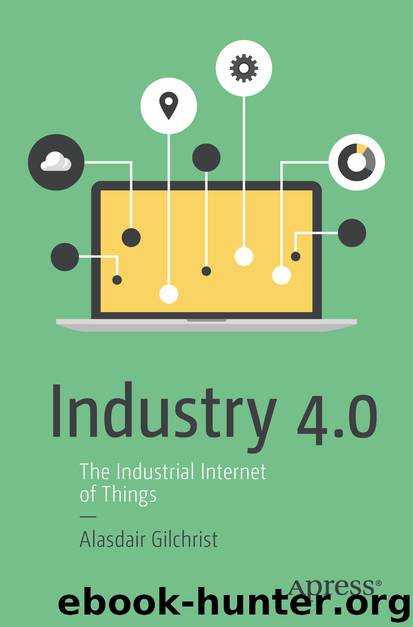Industry 4.0 by Alasdair Gilchrist

Author:Alasdair Gilchrist
Language: eng
Format: epub
Publisher: Apress, Berkeley, CA
Figure 5-6.Diverse protocols in the proximity network
Figure 5-5 shows field bus nodes communicating over an Ethernet Backbone. In Figure 5-6, you can see ZigBee and Bluetooth devices interfacing with an IP access network running IP. Then, Ethernet on copper transforms to an MPLS network running on optical fiber to establish a private line.
The point is that gateways allow us to integrate diverse technologies and protocols onto a common network. This is hugely important when building interconnecting networks. You can build interface complex and diverse heterogeneous networks that look like Figure 5-5.
The main takeaway here is that it doesn’t matter which technology we use in the proximity network to connect our devices; we can still interface through gateways to a common IP infrastructure. Look again at the original simplistic model in Figure 5-6.
We can see that we are not restricted to IP in the proximity network so long as we have a gateway that can handle the transition from the natural format—for example, RS232 to IP/Ethernet.
The big question that then arises, is if there are gateways available to handle this electrical and data format transition between such diverse technologies. Well, yes, there are, and we can demonstrate this in Figure 5-6, where we see many diverse technologies bridging or translating across a gateway device.
It may all sound easy, but here is the problem. Consider the automobile field bus technology CAN. This technology was developed to work at layer 2 of the OSI model, so that every device installed win the car can communicate. However, an application without the car cannot communicate, as there is no application protocol established at layer 7. Consequently, we need an open version of CAN that will allow cars from different manufacturers to communicate by establishing a common layer 7 protocol—hence OpenCAN and DeviceNet. These two cars, or rather their devices, can communicate as they share a common layer 7 application design.
Similarly with IP and Ethernet, all devices that share the same standard can communicate as they share the same common layer 1-4 layer protocols. However, they can communicate but not necessarily understand each other as they do not share the same layer-7 application language. The way that commercial IP/Ethernet gets around this problem is by using standard software protocols such as HTTP, FTP, and SNMP in order to form a common language. However, with Industrial Ethernet it does not require these high-level application protocols. What it need is a real-time protocol to handle data as message exchanges.
However, how do these gateways convert traffic from one network to another? The answer is that they have several techniques; routers for example come with several different interfaces and they inherently have the intelligence and logic to drive and route traffic between them. Therefore, a standard industrial router can accept traffic on an Ethernet port and route that traffic out of a WAN DSL port—in the correct frame format—without any problem. Similarly, it will accept Ethernet traffic through one port and transform the frames to merge into an ATM cell stream and vice versa.
Download
This site does not store any files on its server. We only index and link to content provided by other sites. Please contact the content providers to delete copyright contents if any and email us, we'll remove relevant links or contents immediately.
Bad Blood by John Carreyrou(6543)
Rich Dad Poor Dad by Robert T. Kiyosaki(6398)
Principles: Life and Work by Ray Dalio(6201)
Playing to Win_ How Strategy Really Works by A.G. Lafley & Roger L. Martin(5911)
Management Strategies for the Cloud Revolution: How Cloud Computing Is Transforming Business and Why You Can't Afford to Be Left Behind by Charles Babcock(4521)
The Confidence Code by Katty Kay(4187)
Thinking in Bets by Annie Duke(4152)
American Kingpin by Nick Bilton(3753)
Delivering Happiness by Tony Hsieh(3363)
Project Animal Farm: An Accidental Journey into the Secret World of Farming and the Truth About Our Food by Sonia Faruqi(3174)
The Power of Habit by Charles Duhigg(3059)
The Tyranny of Metrics by Jerry Z. Muller(3000)
Brotopia by Emily Chang(3000)
Mastering Bitcoin: Programming the Open Blockchain by Andreas M. Antonopoulos(2980)
The Marketing Plan Handbook: Develop Big-Picture Marketing Plans for Pennies on the Dollar by Robert W. Bly(2975)
I Live in the Future & Here's How It Works by Nick Bilton(2933)
The Content Trap by Bharat Anand(2860)
Building a StoryBrand by Donald Miller(2838)
Applied Empathy by Michael Ventura(2836)
